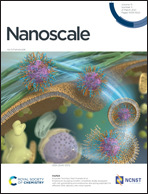Selective manipulation of peptide orientation on hexagonal boron nitride nanosheets†
Abstract
The bio-recognition capabilities of materials-specific peptides offer a promising route to obtaining and organizing 2D nanosheet materials in aqueous media. Although significant advances have been made for graphene, little is currently understood regarding how to apply this strategy to hexagonal boron nitride (h-BN) due to a lack of knowledge regarding peptide/h-BN interactions. Here, one of the few peptide sequences known with affinity for h-BN, BP7, is the focus of mutation studies and bio-conjugation. A combination of experimental methods and modeling reveals the importance of Tyrosine in peptide/h-BN interactions. This residue is identified as the key anchoring species, which is then leveraged via bio-conjugation of BP7 to a fatty acid to create new interfacial properties. Specific placement of the fatty acid in the bio-conjugate results in dramatic manipulation of the surface-bound biotic overlayer to generate a highly viscoelastic interface. This viscoelasticity is a consequence of the fatty acid binding, which also down-modulates Tyrosine contact to h-BN, resulting in presentation of the extended peptide to solution. In this orientation, the biomolecule is available for subsequent bioconjugation, providing new pathways to programmable organization and conjugation of h-BN nanosheets in liquid water.



 Please wait while we load your content...
Please wait while we load your content...